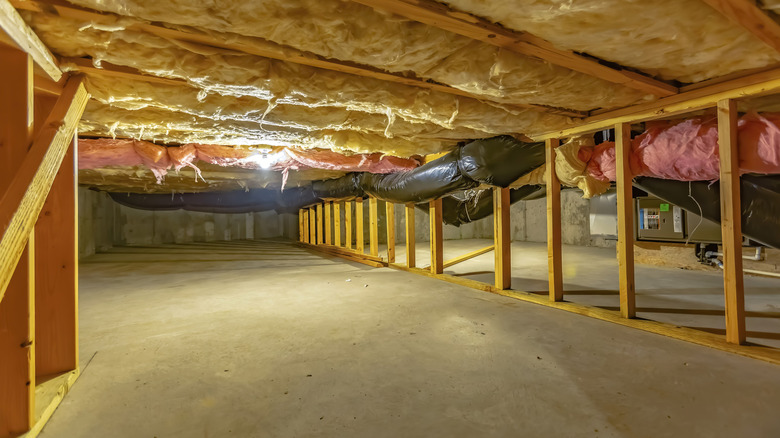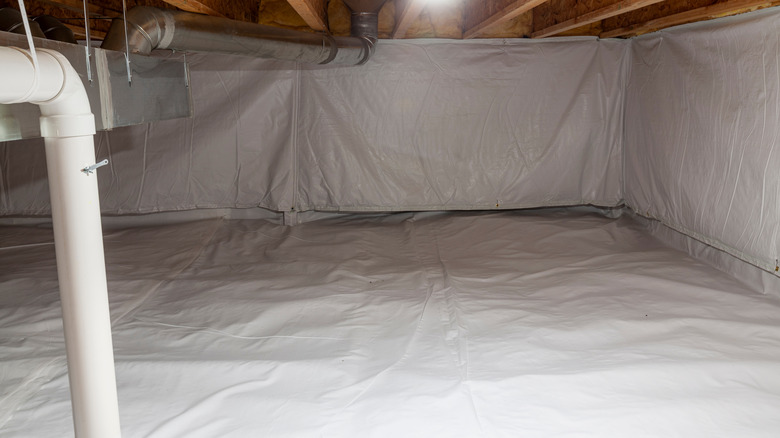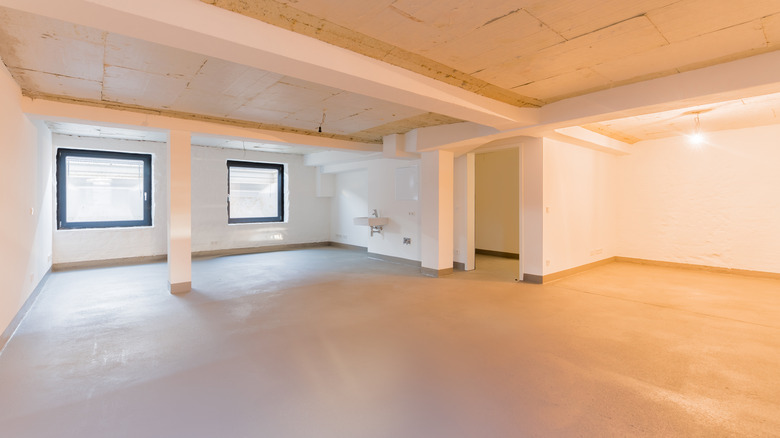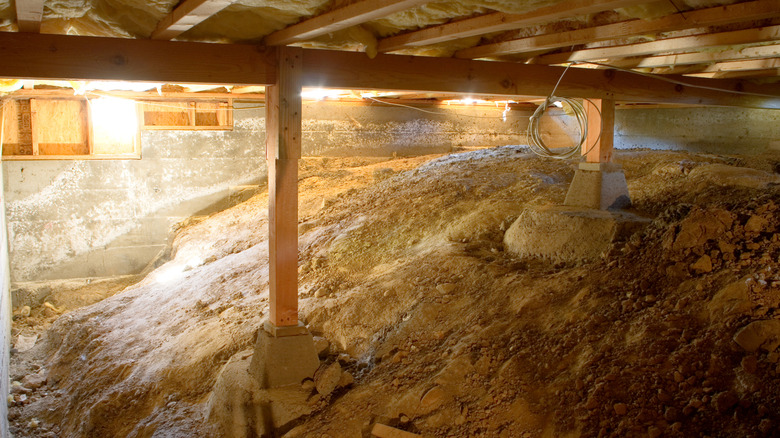The Disadvantages Of A Crawl Space That You Need To Be Aware Of
A crawl space seems like a good solution for the foundation of a home. It's not as expensive as a basement, but it still provides access to mechanicals that run under your home. However, crawl spaces have some significant disadvantages compared to basements and slab foundations. Moisture is often a problem, which can also attract pests. While the crawl space might offer access to ducts and plumbing, it doesn't offer much other functionality. It could even affect how energy-efficient your home is.
That could be why crawl spaces aren't as popular for new-construction homes. Only 9.9% of new homes started in 2023 were built over crawl spaces, according to the National Association of Home Builders. Full or partial basements served as the foundation for 16.6% of homes, while slab foundations accounted for 72.4% of foundations for new homes.
If you're in the market for a new home, learning about the disadvantages of a crawl space foundation might cause you to avoid options that have them. If you already live in a home with a crawl space, you might already be aware of some of the issues. Understanding the problems more can help you discover ways to prevent some of the issues or minimize their effects.
Crawl spaces are often humid
Excess moisture is often a problem in crawl spaces. It's underground and typically becomes damp because of moisture in the soil. Crawl spaces often have vents to allow airflow to prevent humidity. However, moisture from the outside air enters the space if you live in a hot, humid climate. Hot air from the vents in the summer can also create condensation when it meets cooler air that's inside the crawl space. Drainage issues and foundation cracks sometimes make moisture problems worse. You might also have moisture issues if you have a plumbing leak that affects the crawl space.
Since a crawl space isn't a place where you hang out, high humidity might not seem like a problem. However, the high moisture levels can cause serious damage to your home's foundation and to the first floor, which sits right above the crawl space. Mold and mildew growth often causes musty smells that can travel into the main part of your home. Over time, the wood structures that support your floors can soften or rot, which causes your floors to sag. It can also damage any insulation that's in the crawl space.
Crawl space encapsulation helps prevent the damaging moisture issues that often plague these areas. It's a sealing process that uses a vapor barrier to keep moisture from entering. The first step is treating any damage and removing mold. Then, the contractor should repair any issues that increase moisture, such as foundation cracks, before installing the thin plastic barrier. You can also add other devices to minimize moisture like a dehumidifier, drain, or sump pump. However, these solutions can be expensive.
Pests can access crawl spaces easily
Pests like the dark, quiet, damp conditions in crawl spaces. The space provides protection from weather and predators, and the warmth makes your crawl space cozy in the winter. Humidity attracts many pests, including rodents, cockroaches, and termites, so moisture issues could attract the unwanted inhabitants. Plus, rotting wood caused by humidity issues offers a food source for insects like termites and carpenter ants. Insects and animals in your crawl space often go unnoticed, allowing the problem to escalate until your walls are full of unwanted pests.
Unsealed vents offer an easy entrance point into the cavity. Cracks or gaps in your foundation also make it easy for many insects and rodents to enter. If the crawl space has dirt floors, pests can enter through the ground. Termites and carpenter ants chew through wood structures, which can weaken your home's structural support. Rodents also chew on wood, wiring, and other structures. They also potentially carry dangerous pathogens, including hantavirus, which can cause severe respiratory problems in humans. UV light can deactivate the virus, but crawl spaces don't typically see much sunlight. Rodent feces and urine can infect humans with the virus, particularly when it's disturbed.
Controlling moisture problems in your crawl space can help reduce the risk of pest infestations. It also helps to seal any gaps and entrance points where insects and rodents can enter. The encapsulation process typically takes care of both of those issues. You can also add a barrier over a dirt floor that keeps rodents from digging through the dirt to enter your home.
You lose functional space
Crawl spaces can be anywhere from 18 inches to 6 feet tall, but the most common height is about 3 feet. It's not a functional space that you can use for normal activities — it's usually not even suitable as a storm shelter. The area below your home provides a way to run ductwork, plumbing, and other mechanicals to different parts of your home, but that's about the extent of its functionality. It doesn't provide as much protection for any equipment in the space as a basement does.
Using a crawl space for storage depends on the situation. A standard vented crawl space with dirt floors exposes your stored items to moisture and pests, which could cause severe damage. Storage could be safe if you've encapsulated the crawl space and it stays dry and pest-free. However, accessing the stored items isn't as easy as it is in a basement, and storage is limited due to the height of the space.
Meanwhile, basements offer a more functional space with ceilings that are at least 6 feet, 8 inches high. Many homes have basements that are 8 to 10 feet high, leaving room to create a whole new living space on that level. There are also ways to make your unfinished basement more welcoming so it's functional even if it's not finished. Basements offer shelter during storms and keep mechanical components better protected than a crawl space can.
Crawl spaces affect your home's energy efficiency
An uninsulated crawl space with unsealed vents allows hot and cold outside air to enter the space just below your floor. The temperature in the space underneath your feet can affect the temperature in your main living spaces, which means it feels hotter in the summer and colder in the winter. Your HVAC system may run more than normal to overcome that and keep your living space at a comfortable temperature. Your home's crawl space could be affecting the interior's humidity as well, adding to the discomfort and increased workload of your HVAC system. The moisture can infiltrate your living space, which requires more air conditioning to make the space comfortable.
Plumbing lines and ductwork that run through the crawl space are often affected by the temperatures as well. Leaks in your ducts can allow the heated or cooled air to escape in the crawl space. Pests in the crawl space could damage the ducts, making this a bigger problem. Cold air in the winter can also make the water colder. Your water heater may need to work harder to heat the water properly.
Adding insulation to the walls, ceiling, and access door in the crawl space reduces the temperature fluctuations in the space. This helps keep your home's main living space more comfortable and reduces the strain on your HVAC system. Encapsulation and dehumidifying activities minimize the uncomfortable effects of excess humidity. Inspecting and repairing damaged ductwork in the crawl space can improve the efficiency of your HVAC system. It can also help to insulate the ductwork and plumbing lines that pass through the space.




